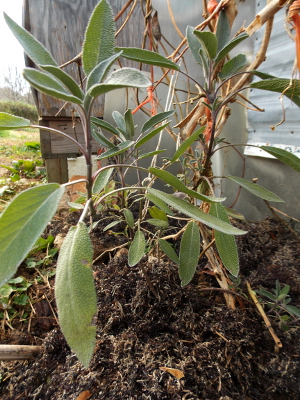
Uses for seaweed on the homestead
 In Weekend Homesteader: October,
one of the projects I suggest is spending some time scavenging free
biomass for use on the garden. I barely touched on seaweed in that
chapter, including it only because I'd read that some people use seaweed
as mulch. But while Mark and I were at the beach last month, I decided to collect a bagful and bring it home as an experiment.
In Weekend Homesteader: October,
one of the projects I suggest is spending some time scavenging free
biomass for use on the garden. I barely touched on seaweed in that
chapter, including it only because I'd read that some people use seaweed
as mulch. But while Mark and I were at the beach last month, I decided to collect a bagful and bring it home as an experiment.
My first impulse, actually, was to feed the seaweed to the goats instead. After all, we offer kelp as a source of salt and micronutrients, so surely seaweed would be even better, right? A search of the internet found that some people do
feed seaweed to goats, but that you really have to find a source of
fresh, live seaweed and scrape it off the rocks (at which point I'd
start to worry about damaging the ecosystem). The seaweed that so
copiously washes up on our shores is instead dead and beginning to rot,
so isn't very healthy for our caprine friends.
But when applied to the
garden, the same seaweed shines. The bag I brought home went a long way,
mulching around a sage plant, a newly-transplanted grape, and a young
hardy kiwi. With a C:N
of 19:1, the mulch will probably rot down quickly, and I'd have to keep
an eye on salt levels if I used seaweed as a mulch on a regular basis.
But as it is, I suspect the top-dressed plants will get a boost in the
trace-mineral department and should grow quite well.
I'll keep you posted
about the results of my experiment, but in the meantime I'd love to hear
from those of you who live by the shore and presumably have plenty of
seaweed to throw at your gardens. Do you love it? Hate it? Somewhere in
between? Does it make up for painfully sandy, low-organic-matter soil?
Want more in-depth information? Browse through our books.
Or explore more posts by date or by subject.
About us: Anna Hess and Mark Hamilton spent over a decade living self-sufficiently in the mountains of Virginia before moving north to start over from scratch in the foothills of Ohio. They've experimented with permaculture, no-till gardening, trailersteading, home-based microbusinesses and much more, writing about their adventures in both blogs and books.
Want to be notified when new comments are posted on this page? Click on the RSS button after you add a comment to subscribe to the comment feed, or simply check the box beside "email replies to me" while writing your comment.

Anna, this reminds me of the potato farmers on the Island of Jersey, they fertilize with seaweed. http://www.jerseyroyals.co.uk/about-jersey-royals.aspx
Hi All,
We travel to the coast once and a while.
We usually fill 50 gallon bottles with seawater and fill 3 5gallon pails with not so fresh seaweed.
Both are dumped straight on the garden.
I notice the flies are quite active around the seaweed for several weeks.
The seawater seems to spike growth for quite a while after pouring it on. Probably because the electrical conductivity goes up a lot.
There is a most interesting interview with E. Coleman in which he talks about adding hay and seafood trash to his garden for many years. And that keeping the produce bug free and high in Brix.
John
When establishing my backyard I covered it with four inches of sea grass that had been washed up on the beach during a storm. There was some seaweed mixed in with it. A self seeded peach tree came up which I allowed to grow. It grew five feet a year and got so big I had to prune it hard because I couldn't reach the peaches even with a 20 foot pole!
I live in a dry climate so it took about a year for the seagrass to rot down. Everything I plant in the soil it created does extremely well. Worms love it. I poured 10 gallons of undiluted sea water around the peach tree this year and it looks like I'm going to get a big crop of peaches - no negative effects. Worms are still there.
There was a patch of my front lawn that wasn't doing too well compared to the rest of my lawn. I dissolved 2 heaped teaspoon fulls of Himalayan salt in hot water and added it to a watering can full of tap water then watered the lawn patch. It's now the same as the rest of the lawn.
A certain amount of salt aids soil fertility. Consult "Sea Energy Agriculture" by Maynard Murray if you have any doubts.